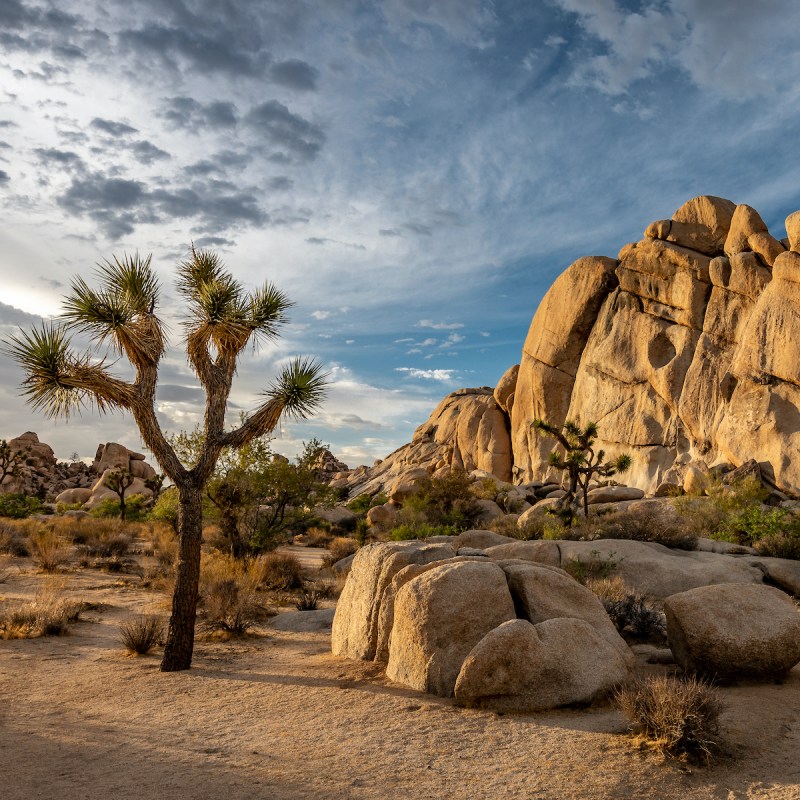
Nestled alongside the popular Joshua Tree National Park, a massive swath of land stretching from just east of Palm Springs in the Coachella Valley nearly to the Arizona border is under study to become America’s newest national monument. A coalition of environmental groups hopes the designation will protect native species, indigenous heritage sites, and the raw beauty of these desert landscapes for generations to come. If successful, the Chuckwalla National Monument will become a place visitors to the California desert will have on their list of must-see sights.
Videos by TravelAwaits
What Can Be A National Monument?
When people think about national monuments, the Lincoln Memorial in Washington or the Gateway Arch in St. Louis might come to mind, but those do not fall under the “national monument” designation. The term refers instead to land or water that is seen as significant to the nation and deserving of protection. A federal law called the Antiquities Act of 1906, signed by President Theodore Roosevelt, gives the president the power to establish national monuments.
Congress can also designate lands as national monuments. Roosevelt named Devil’s Tower in Wyoming as the first national monument. At last count, there are now 145, ranging from Governors Island National Monument in New York to Mount Saint Helens Volcanic National Monument in Washington.
What’s The Process To Become A National Monument?
The actual act of creating a national monument is quite simple. Once the president signs a declaration creating the monument, it’s done — the new monument exists. President Biden designated his first national monument — the Camp Hale-Continental Divide National Monument in Colorado — in October 2022. The complicated part comes in the fight to get the designation. Typically, local interest groups find a parcel of land that needs protection and makes the case to the president’s office that it needs national monument status.
That’s what is underway right now for the Chuckwalla land. Groups like Audubon California, the CactustoCloud Institute, and the California Wilderness Coalition are working through lawmakers and other channels to get Biden to act on the request. Opponents to a national monument designation usually come from groups like the Blue Ribbon Coalition that want unrestricted use of the land for off-roading and other recreational activities. Desert spaces are ripe for development as solar farms can also face opposition, but the proposal for Chuckwalla carves out those areas to remain open for development.
Where Can People Visit Now?
While activists await action on their proposal, visitors to the California desert can see the highlights of the area without waiting for it to officially become a national monument. Though the land proposed for the monument covers more than 1,000 square miles, the most accessible parts of it are close to a favorite vacation spot for those enjoying the California desert, Palm Springs. The Coachella Valley lies at the westernmost tip of the proposed monument area and has several attractions close to the golf courses and resorts of the greater Palm Springs area.
The Mecca Hills Wilderness lies at the far end of the Coachella Valley, about an hour’s drive from Palm Springs just north of the Salton Sea. Visitors can take I-10 to CA 111 south into Mecca, turning east on 66th Avenue to reach the wilderness area. At the site, you’ll see the power of the San Andreas fault in action, having created steep canyon walls and a winding path through beautiful rock formations. Nineteen trails stretch through the wilderness area with Little Painted Canyon Trail and Ladder Canyon Trail among the most popular.
Right next door is the Orocopia Mountain Wilderness, a more primitive stretch of land that features many of the same fault-driven features as Mecca Hills. The Red Canyon Trail here is designed for off-road vehicles to explore a 27-mile loop through the desert. Organizers of the effort to get the national monument designation have plans for this and other off-road areas in the lands to remain accessible to vehicles.
About 90 minutes to the east of the Mecca Hills and Orocopia Mountain lies the Chuckwalla Mountains Wilderness, a 150-square-mile region of mountain peaks and desert landscapes. The attraction here is the remote nature of the land where campers and hikers are likely to see bighorn sheep, coyotes, and even wild burros. Off-roading is currently permitted here, too, with two extensive trails that take in a lot of desert landscape.
The more eastern reaches of the land that could become Chuckwalla National Monument are remote and largely undeveloped. If you want to travel the entire expanse of the proposed monument, end your trip in Palo Verde, California, near the Colorado River and the Arizona border. The Palo Verde Mountains Wilderness there boasts one of the most impressive slot canyons in this part of the desert, but roads in and out of the area are scarce. This part of the area is only for the heartiest of hikers and adventurers.
There’s no timetable on when — or even if — the Biden Administration will move on making the Chuckwalla National Monument a reality, but there is definitely a timetable for the best times to visit the area. The desert hikes listed here are best in the late fall, winter, and early spring when daytime temperatures stay in a reasonable range. Summer visits should be limited to early morning hours just after sunrise before temperatures reach deadly levels.
For more information on traveling to California, check out these articles:
